Improving Alfalfa’s Flood and Drought Tolerance 🎙️

This article written by Dr. Reynold Bergen, BCRC Science Director, originally appeared in the April 2023 issue of Canadian Cattlemen magazine and is reprinted on BeefResearch.ca with permission of the publisher.
CLICK THE PLAY BUTTON TO LISTEN TO THIS ARTICLE:
One of last year’s research columns bemoaned the fact that only four out of 119 alfalfa varieties registered in Canada between 2012 and 2022 had been developed in Canada. The rest were from China, Australia or the U.S.
Since then, the CFIA has approved nine more varieties originating from Washington, Wisconsin, Idaho or California. These latest varieties have all been selected for yield and resistance to a variety of biotic (living) threats posed by insects, worms, bacteria and fungi. Two of them have been selected for winterhardiness, but none mention any selection for resistance to other environmental threats like flood or drought. Several of them had been tested in Minnesota, Wisconsin, Washington and Idaho, but as far as I could tell, none had been evaluated in Canada before being registered.
Anyone who’s purchased breeding stock from another region, then watched them shrivel up, lose condition, fail to rebreed and fall out of your herd understands the importance of developing genetics to match the environment they’re expected to work in. The same thing applies to forage crops. With Canada’s best agricultural land being seeded to soybeans, canola, lentils, corn and other high value annual crops, forages need to be able to survive and thrive in poorer quality soils that are often more subject to drought, flooding or both–sometimes in the same year. Can we really expect alfalfa genetics to cope with drought or flood when they’ve never been tested under those conditions?
Agriculture and Agri-Food Canada researchers led by Abdelali Hannoufa in London, Ontario, are investigating the genetic mechanisms underlying flooding tolerance (Involvement of the miR156/SPL module in flooding response in Medicago sativa), and a team of AAFC Lethbridge researchers led by Stacy Singer in Lethbridge are studying drought tolerance (The CRISPR/Cas9-mediated modulation of squamosa promoter-binding protein-like 8 in alfalfa leads to distinct phenotypic outcomes).
What They Did

Because flooding and drought are very difficult to accurately predict under field conditions, these experiments used alfalfa plants grown in pots under greenhouse conditions. This allowed the experimental flood and drought conditions to be tightly controlled. The London team used AC Caribou (a 1990 Quebec variety with good winter survival but poor flooding tolerance), AAC Trueman (a 2018 Nova Scotia variety with improved flooding tolerance) and some experimental alfalfa lines. They compared plants grown in well-drained conditions to plants that were submerged to the soil surface for two weeks. The Alberta team exposed some experimental and background lines of alfalfa to severe drought and subsequent re-watering. Both experiments evaluated plant growth responses and changes in gene expression under optimal vs. stressed growing conditions (i.e., flood or drought).
What They Learned
In London, all lines grew equally well and showed similar gene expression patterns when the soil was well-drained. But thousands of different genes were switched on or off when alfalfa plants were flooded. The flood-tolerant lines turned down the expression of genes involved in photosynthesis. Other genes were turned up, including a “snorkel” gene which is also known to help rice plants cope with flooding. Another up-regulated gene helps to controls the production of a hormone called abscisic acid, which is involved in water retention and loss in plants. Flooding negatively affected all the alfalfa lines, but the flood-susceptible lines were much more heavily damaged.
In Lethbridge, plant height, branch number and weight were similar in all alfalfa lines under well-watered growing conditions, although the drought-tolerant lines had smaller leaves. Plants with higher levels of drought tolerance had more copies of a mutated gene that is involved in branching, regrowth and yield. When stressed, the drought-tolerant alfalfa lines wilted less, retained higher water content, continued photosynthesizing and had double the survival rate of the other lines.
So, What Does This Mean…to You?

These are early days, but identifying genes that play key roles in stress tolerance will help to breed alfalfa that is more resilient to environmental challenges. Alfalfa is notoriously susceptible to flooding damage, so identifying and understanding the gene combinations that are associated with superior survival under flood conditions is the first step to developing more flood-tolerant varieties. Alfalfa’s deep taproot generally helps it survive drought better than more shallow-rooted grasses. But the Lethbridge results indicate that certain genetic combinations may help alfalfa to cope with and recover from drought better than the varieties we currently have. It will take many more years and ultimately long-term field trials to see how well these differences translate to field and commercial production conditions, and to determine what trade-offs may exist between environmental resiliency and forage yield and quality. But it’s pretty safe to say that an alfalfa stand that survives and recovers better after a flood or drought will outyield an alfalfa stand that is weakened or dies as a result of a flood or drought.
Bottom line: Even with climate changes, Canada will continue to have longer, colder winters and shorter growing seasons than most of the rest of the world. Flood and drought will never go away. Canada’s forage breeders are developing improved alfalfa genetics to cope with Canada’s environmental extremes.
The Beef Cattle Research Council is funded by the Canadian Beef Cattle Check-Off. The BCRC partners with Agriculture and Agri-Food Canada, provincial beef industry groups and governments to advance research and technology transfer supporting the Canadian beef industry’s vision to be recognized as a preferred supplier of healthy, high-quality beef, cattle, and genetics.
Click here to subscribe to the BCRC Blog and receive email notifications when new content is posted.
The sharing or reprinting of BCRC Blog articles is typically welcome and encouraged, however this article requires permission of the original publisher.
We welcome your questions, comments and suggestions. Contact us directly or generate public discussion by posting your thoughts below.